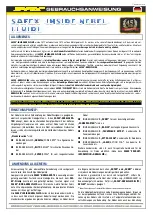
router will not accept the call (based on configured call restrictions), it
immediately drops DTR. Otherwise the adapter subsequently drops CTS. As
soon as the switched circuit is complete, DSR (data set ready) is raised by
each adapter and the circuit is established.
Any of the synchronous interfaces except X.21 (that is, RS-232/V.24/V.28,
V.35, RS-449/422/V.36) may be used to connect to a V.25 bis adapter. The X.21
interface lacks the necessary hardware-control signals required to imple-
ment V.25 bis.
Connections may be initiated in one of two ways with a V.25 bis adapter:
When data is available or on incoming call
When the circuit is enabled
Table 4.
Valid Connection Initiation Parameters for V.25 bis
Circuit Group Members and Backup Members
Side A Router
Side B Router
Circuit is enabled
Circuit is enabled
Circuit is enabled
Data is available or on incoming call
Data is available or on incoming call
Circuit is enabled
Data is available or on incoming call
Data is available or on incoming call
The valid combinations of connection initiation parameters for circuit group
members and circuit group backup members using V.25 bis adapters are
shown in the shaded fields of table 4. Pool circuit group members can
only
be configured to connect when “data is available or on incoming call”.
As in the case of manual adapters, when the connection initiation
paramenter is set to “circuit is enabled” on both sides, the circuit will never
hang up. The user will incur charges for a permanently open circuit!
Connection Controls—V.25 bis Adapter
V.25 bis circuits provide the same connection controls as described
previously in the section “Connection Controls—Manual Adapter”. In
addition, call restrictions may be configured with V.25 bis circuits. This
involves specifying a list of originating phone numbers for which incoming
calls will be accepted. Note that these call restrictions only work on ISDN
networks with automatic number identification (ANI).
Improving Network Availability
Switched Circuit Types
3-22
Summary of Contents for 600 Series
Page 1: ...Hewlett Packard Series 200 400 and 600 Routers HP Routing Services and Applications ...
Page 4: ......
Page 5: ...1 Product Notes ...
Page 6: ...Features of HP Routers Architecture and Technology Branch Office Routing Product Notes 1 2 ...
Page 38: ...Architecture and Technology Software Control Path Architecture 1 34 ...
Page 52: ...Branch Office Routing Future Directions 1 48 ...
Page 53: ...2 Routing Services Notes ...
Page 106: ...Bridging Service Traffic Prioritization 2 54 ...
Page 158: ...Novell IPX Routing Service NetBIOS Protocol Support 2 106 ...
Page 194: ...Data Compression for WAN Links Conclusion 2 142 ...
Page 195: ...3 Application Notes and Case Studies ...
Page 224: ...Improving Network Availability Application Recovery 3 30 ...
Page 234: ...ISDN Wide Area Network Design Dry Creek Joint Elem School District Performance 3 40 ...
Page 316: ......
















































